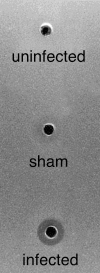Induction of the Yersinia pestis PhoP-PhoQ regulatory system in the flea and its role in producing a transmissible infection
- PMID: 23435973
- PMCID: PMC3624595
- DOI: 10.1128/JB.02000-12
Induction of the Yersinia pestis PhoP-PhoQ regulatory system in the flea and its role in producing a transmissible infection
Abstract
Transmission of Yersinia pestis is greatly enhanced after it forms a bacterial biofilm in the foregut of the flea vector that interferes with normal blood feeding. Here we report that the ability to produce a normal foregut-blocking infection depends on induction of the Y. pestis PhoP-PhoQ two-component regulatory system in the flea. Y. pestis phoP-negative mutants achieved normal infection rates and bacterial loads in the flea midgut but produced a less cohesive biofilm both in vitro and in the flea and had a greatly reduced ability to localize to and block the flea foregut. Thus, not only is the PhoP-PhoQ system induced in the flea gut environment, but also this induction is required to produce a normal transmissible infection. The altered biofilm phenotype in the flea was not due to lack of PhoPQ-dependent or PmrAB-dependent addition of aminoarabinose to the Y. pestis lipid A, because an aminoarabinose-deficient mutant that is highly sensitive to cationic antimicrobial peptides had a normal phenotype in the flea digestive tract. In addition to enhancing transmissibility, induction of the PhoP-PhoQ system in the arthropod vector prior to transmission may preadapt Y. pestis to resist the initial encounter with the mammalian innate immune response.
Figures






References
-
- Miller JF, Mekalanos JJ, Falkow S. 1989. Coordinate regulation and sensory transduction in the control of bacterial virulence. Science 243:916–922 - PubMed
-
- Moss JE, Fisher PE, Vick B, Groisman EA, Zychlinsky A. 2000. The regulatory protein PhoP controls susceptibility to the host inflammatory response in Shigella flexneri. Cell. Microbiol. 2:443–452 - PubMed
Publication types
MeSH terms
Substances
Grants and funding
LinkOut - more resources
Full Text Sources
Other Literature Sources
Medical

